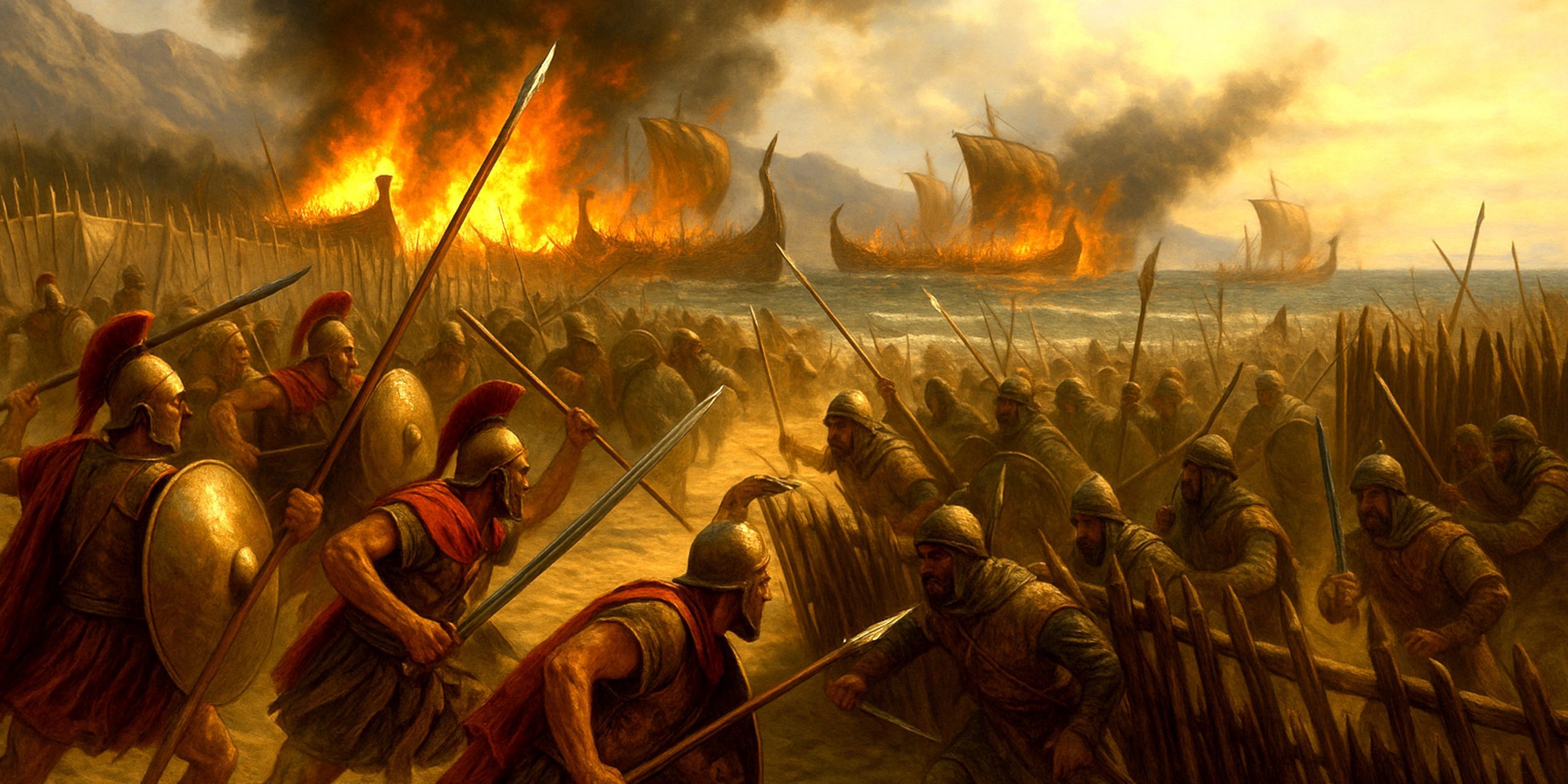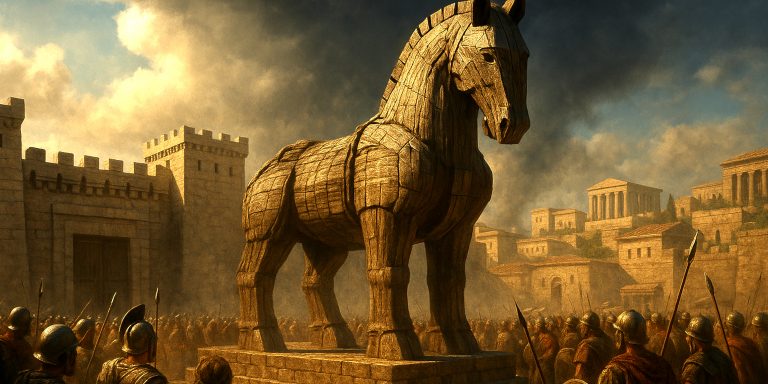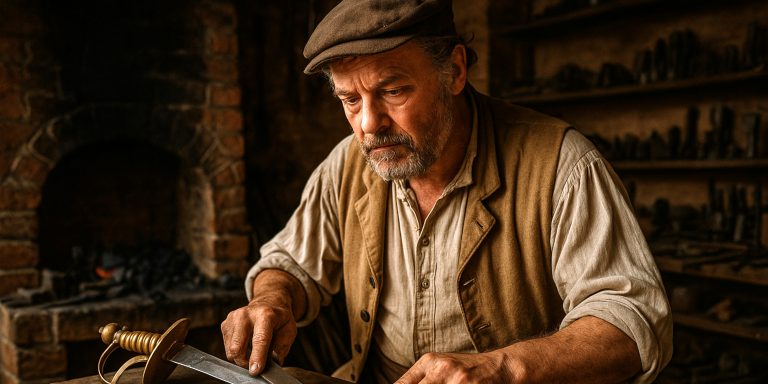
The Battle of Mycale was fought in 479 BC on the coast of Ionia, near Mount Mycale opposite the island of Samos. It was one of the decisive clashes that ended the Persian invasion of Greece. Occurring almost simultaneously with the Greek victory at Plataea, this encounter marked the destruction of Persian naval power in the Aegean. For all intents and purposes, it was the moment the tide turned from defence to revenge.
Herodotus called it “a twin victory,” as if the gods had decided Greece deserved a matching set.
Background
After their defeat at Salamis the previous year, the Persians under King Xerxes had withdrawn most of their forces from Greece. The remainder, commanded by Artayntes and others, stayed to hold the western coastal strongholds and suppress the rebellious Ionian Greeks.
The Greeks, under the Spartan king Leotychidas and the Athenian commander Xanthippus, sailed across the Aegean to liberate their kinsmen. When they reached Samos, they discovered that the Persian fleet, wary of open battle, had beached its ships under the protection of their land army near Mount Mycale.
The Greeks, never ones to ignore a challenge, landed and formed up for an assault.
Forces
| Side | Commanders | Estimated Troops | Fleet Strength | Allies |
|---|---|---|---|---|
| Greek Alliance | Leotychidas (Sparta), Xanthippus (Athens) | 30,000 men (including rowers turned infantry) | c. 250 triremes | Ionian Greeks, Samians |
| Achaemenid Persia | Artayntes, Tigranes, Mardontes | 60,000 men (mixed Persians, Medes, and Ionian levies) | c. 300 ships (beached and fortified) | Ionian and Carian conscripts |
Note: Persian numbers are notoriously inflated by ancient sources. Herodotus had a flair for exaggeration, but even by conservative estimates, the Persians heavily outnumbered the Greeks.
Leaders and Troop Composition
Greek Alliance:
- Spartans: Core hoplite infantry, disciplined and armoured in bronze cuirasses, Corinthian helmets, and greaves.
- Athenians: Lighter hoplites and experienced sailors fighting as marines.
- Ionian allies: Recently rebellious Greeks providing auxiliary troops and intelligence.
Persian Forces:
- Persian infantry: Archers and spearmen, many equipped with wicker shields and scale armour.
- Ionian and Carian levies: Poorly motivated, many defected mid-battle.
- Command staff: Artayntes, Tigranes, and Mardontes, experienced but overstretched generals tasked with defending a fleet now useless on land.
Arms and Armour
Greek Equipment
- Primary weapons: Dory (spear, approx. 2.5m long), xiphos (short sword), kopis (curved slashing sword used by some Athenians).
- Defensive gear: Bronze cuirass or linothorax, Corinthian helmet, aspis (large round shield).
- Naval infantry: Carried lighter versions for mobility when disembarking.
Persian Equipment
- Primary weapons: Composite bows, akinakes (short Persian sword), spears.
- Defensive gear: Scale or quilted armour, light shields of wicker or hide.
- Tactical weakness: Inferior in close combat to heavily armed hoplites; relied on range and numbers.
The Battle
When Leotychidas landed his force near Mycale, he addressed his troops, declaring:
“We fight not only for Greece but for those Greeks still in bondage.”
The Persian camp was fortified with palisades and drawn-up ships. The Greeks advanced uphill, the Spartans on one flank, Athenians and Ionians on the other. Persian arrows darkened the air, but the hoplite wall pressed forward.
The Persian line broke under the weight of the charge. Once the defection of the Ionian levies began, panic spread. The Greek forces stormed the camp, setting fire to the Persian ships and cutting down any resistance. By nightfall, the beach was a chaos of burning timber and fleeing soldiers.
A Persian once said, “The Greeks fight as if each man were his own king.” That was precisely the problem.
Archaeology
The exact site of the battle remains uncertain, though the general location near modern Kuşadası in Turkey fits Herodotus’ account. Excavations in the region have uncovered pottery, spearheads, and arrowheads from the late 5th century BC, suggesting military activity. Some researchers believe submerged remains off the coast of Mykale could be part of the Persian fleet that burned and sank there.
Interestingly, local fishermen have reported retrieving fragments of bronze armour in their nets, likely relics of the battle or subsequent coastal raids.
Battle Timeline
| Timeframe | Event |
|---|---|
| Early 479 BC | Greek fleet gathers at Delos under Leotychidas. |
| Mid-year | Greeks sail east, encouraged by Ionian rebellion. |
| Late summer 479 BC | Persian fleet retreats and beaches at Mycale. |
| Same day as Battle of Plataea (coincidence noted by Herodotus) | Greeks land and attack. |
| Afternoon | Greek hoplites breach Persian lines; Ionian defectors turn the tide. |
| Evening | Persian camp and fleet burned; survivors flee inland. |
| Aftermath | Ionia effectively liberated; Persian power in the Aegean collapses. |
Aftermath and Legacy
The twin victories at Plataea and Mycale ended the Persian threat to mainland Greece and freed the Ionian cities. For Sparta, it marked the limit of their overseas ambition. For Athens, it marked the beginning of an empire, the Delian League was founded soon after, supposedly as a defensive alliance but quickly becoming an Athenian dominion.
The Persian response was muted. Xerxes had bigger concerns at home and fewer ships to spare. As Herodotus dryly observed, “The sea itself turned Greek.”
Contemporary Quotes
- Herodotus, Histories IX.102:
“On the same day that the Persians were defeated at Plataea, another blow befell them at Mycale.” - Plutarch (later commentary):
“So the Greeks fought not only with men, but with the echo of their own courage.” - Modern reflection:
As one archaeologist quipped, “If Salamis was the storm, Mycale was the clean-up crew.”
The Severn Swords Takeaway
The Battle of Mycale was more than a military engagement. It symbolised the transformation of Greece from a collection of threatened city-states into a confident maritime power. It also proved that Persian imperial might could be not only resisted but humiliated.
Standing on that beach, the Greeks had fought for freedom, and in doing so, set fire to the last embers of Xerxes’ grand ambitions. One can almost imagine the flames reflecting on their bronze helmets, a fitting glow for the end of an empire’s reach.
Watch the documentary:



